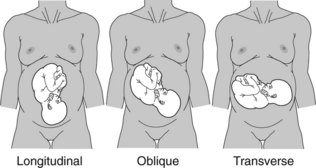Chapter 5 Admission to labour ward
ADMISSION FOR LABOUR
Organisational requirements
Requirements for quality care
Cultural changes prompted by better information, national (for example ‘Changing childbirth’ (Brown and Lumley 1998)) and international (for example National Health and Medical Research Council (NHMRC) 1996) directives, and surveys indicate women and their partners expect quality and satisfaction in addition to safe delivery. There is evidence to show the following contribute to perceived quality and satisfaction:
Labour is the most common reason for admission.
ASSESSMENT FOLLOWING ADMISSION
Presentation
This describes the fetal part presented or nearest to the cervix, e.g. cephalic presentation.
Lie
This defines the relation between the longitudinal axis of the fetus and that of the mother (Figure 5.1).
Engagement
This occurs when the biparietal (vertex) or bi-ischial (breech) diameters descend below the pelvic brim. Descent of the fetal head into the pelvis is usually described as if the head is divided into five segments. The head would be engaged if less than three-fifths were palpable above the pelvic brim (Figure 5.2).
Auscultation
Auscultate with a Pinard stethoscope (Figure 5.3). The position of the anterior shoulder is further from the midline in the occipito-lateral and posterior positions.
Examination of abdomen and pelvis
Stay updated, free articles. Join our Telegram channel

Full access? Get Clinical Tree





